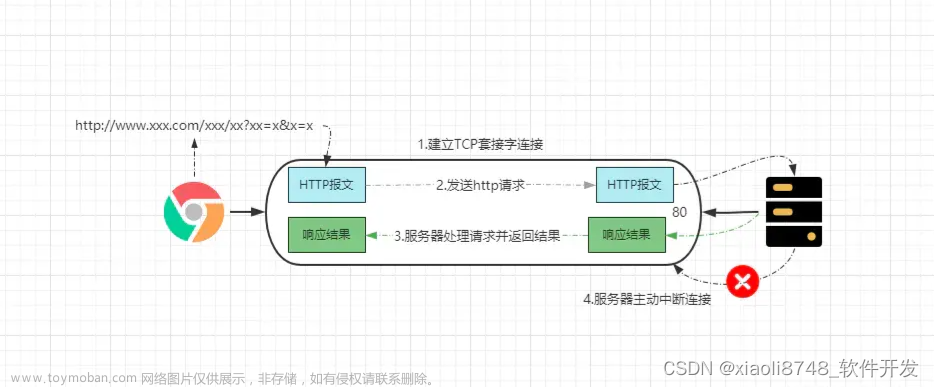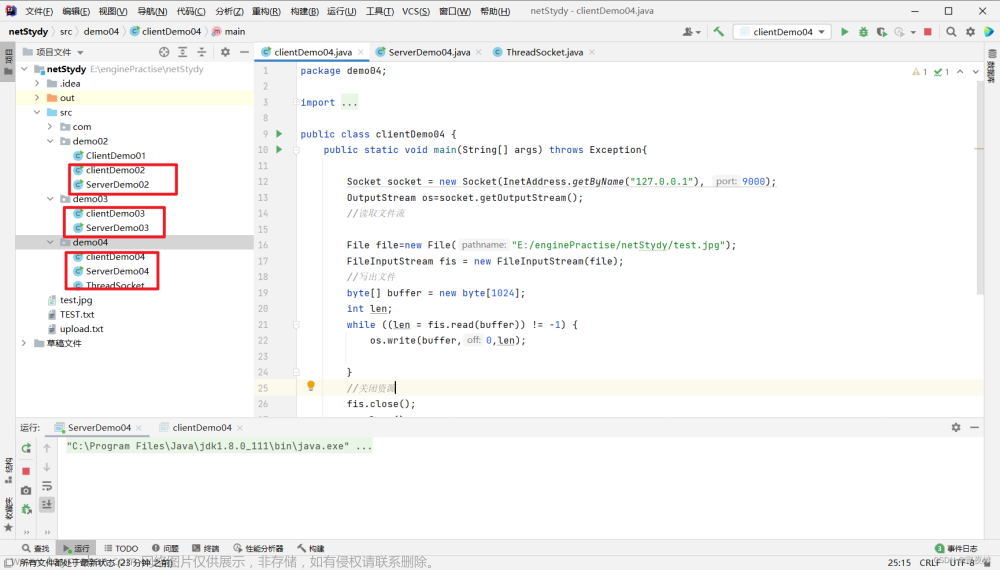HTTP 概述
HTTP 客户程序必须先发出一个 HTTP 请求,然后才能接收到来自 HTTP 服器的响应,浏览器就是最常见的 HTTP 客户程序。HTTP 客户程序和 HTTP 服务器分别由不同的软件开发商提供,它们都可以用任意的编程语言编写。HTTP 严格规定了 HTTP 请求和 HTTP 响应的数据格式,只要 HTTP 服务器与客户程序都遵守 HTTP,就能彼此看得懂对方发送的消息
1. HTTP 请求格式
下面是一个 HTTP 请求的例子
POST /hello.jsp HTTP/1.1
Accept:image/gif, image/jpeg, */*
Referer: http://localhost/login.htm
Accept-Language: en,zh-cn;q=0.5
Content-Type: application/x-www-form-urlencoded
Accept-Encoding: gzip, deflate
User-Agent: Mozilla/4.0 (compatible; MSIE 6.0; Windows NT 10.0)
Host: localhost
Content-Length:43
Connection: Keep-Alive
Cache-Control: no-cache
username=root&password=12346&submit=submit
HTTP 规定,HTTP 请求由三部分构成,分别是:
-
请求方法、URI、HTTP 的版本
- HTTP 请求的第一行包括请求方式、URI 和协议版本这三项内容,以空格分开:
POST /hello.jsp HTTP/1.1
- HTTP 请求的第一行包括请求方式、URI 和协议版本这三项内容,以空格分开:
-
请求头(Request Header)
-
请求头包含许多有关客户端环境和请求正文的有用信息。例如,请求头可以声明浏览器的类型、所用的语言、请求正文的类型,以及请求正文的长度等
Accept:image/gif, image/jpeg, */* Referer: http://localhost/login.htm Accept-Language: en,zh-cn;q=0.5 //浏览器所用的语言 Content-Type: application/x-www-form-urlencoded //正文类型 Accept-Encoding: gzip, deflate User-Agent: Mozilla/4.0 (compatible; MSIE 6.0; Windows NT 10.0) //浏览器类型 Host: localhost //远程主机 Content-Length:43 //正文长度 Connection: Keep-Alive Cache-Control: no-cache
-
-
请求正文(Request Content)
-
HTTP 规定,请求头和请求正文之间必须以空行分割(即只有 CRLF 符号的行),这个空行非常重要,它表示请求头已经结束,接下来是请求正文,请求正文中可以包含客户以 POST 方式提交的表单数据
username=root&password=12346&submit=submit
-
2. HTTP 响应格式
下面是一个 HTTP 响应的例子
HTTP/1.1 200 0K
Server: nio/1.1
Content-type: text/html; charset=GBK
Content-length:97
<html>
<head>
<title>helloapp</title>
</head>
<body >
<h1>hello</h1>
</body>
</htm1>
HTTP 响应也由三部分构成,分别是:
-
HTTP 的版本、状态代码、描述
- HTTP 响应的第一行包括服务器使用的 HTTP 的版本、状态代码,以及对状态代码的描述,这三项内容之间以空格分割
-
响应头 (Response Header)
-
响应头也和请求头一样包含许多有用的信息,例如服务器类型、正文类型和正文长度等
Server: nio/1.1 //服务器类型 Content-type: text/html; charset=GBK //正文类型 Content-length:97 //正文长度
-
-
响应正文(Response Content)
-
响应正文就是服务器返回的具体的文档,最常见的是 HTML 网页。HTTP 响应头与响应正文之间也必须用空行分隔
<html> <head> <title>helloapp</title> </head> <body > <h1>hello</h1> </body> </htm1>
-
创建阻塞的 HTTP 服务器
下例(SimpleHttpServer)创建了一个非常简单的 HTTP 服务器,它接收客户程序的 HTTP 请求,把它打印到控制台。然后对 HTTP 请求做简单的解析,如果客户程序请求访问 login.htm,就返回该网页,否则一律返回 hello.htm 网页。login.htm 和 hello.htm 文件位于 root 目录下
SimpleHttpServer 监听 80 端口,按照阻塞模式工作,采用线程池来处理每个客户请求
public class SimpleHttpServer {
private int port = 80;
private ServerSocketChannel serverSocketChannel = null;
private ExecutorService executorService;
private static final int POOL MULTIPLE = 4;
private Charset charset = Charset.forName("GBK");
public SimpleHttpServer() throws IOException {
executorService= Executors.newFixedThreadPool(Runtime.getRuntime().availableProcessors() * POOL MULTIPLE);
serverSocketChannel = ServerSocketChannel.open();
serverSocketChannel.socket().setReuseAddress(true);
serverSocketChannel.socket().bind(new InetSocketAddress(port));
System.out.println("服务器启动");
}
public void service() {
while (true) {
SocketChannel socketChannel = null;
try {
socketChannel = serverSocketChannel.accept();
executorService.execute(new Handler(socketChannel));
} catch (IOException e) {
e.printStackTrace();
}
}
}
public static void main(String args[])throws IOException {
new SimpleHttpServer().service();
}
public String decode(ByteBuffer buffer) {......} //解码
public ByteBuffer encode(String str) {......} //编码
//Handler是内部类,负责处理HTTP请求
class Handler implements Runnable {
private SocketChannel socketChannel;
public Handler(SocketChannel socketChannel) {
this.socketChannel = socketChannel;
}
public void run() {
handle(socketChannel);
}
public void handle(SocketChannel socketChannel) {
try {
Socket socket = socketChannel.socket();
ByteBuffer buffer = ByteBuffer.allocate(1024);
//接收HTTP请求,假定其长度不超过1024字节
socketChannel.read(buffer);
buffer.flip();
String request = decode(buffer);
//打印HTTP请求
System.out.print(request);
//生成HTTP响应结果
StringBuffer sb = new StringBuffer("HTTP/1.1 200 0K\r\n");
sb.append("Content-Type:text/html\r\n\r\n");
//发送HTTP响应的第1行和响应头
socketChannel.write(encode(sb.toString()));
FileInputStream in;
//获得HTTP请求的第1行
String firstLineOfRequest = request.substring(0, request.indexOf("\r\n"));
if(firstLineOfRequest.indexOf("login.htm") != -1) {
in = new FileInputStream("login.htm");
} else {
in = new FileInputStream("hello.htm");
}
FileChannel fileChannel = in.getChannel();
//发送响应正文
fileChannel.transferTo(0, fileChannel.size(), socketChannel);
} catch (Exception e) {
e.printStackTrace();
} finally {
try {
if(socketChannel != null) {
//关闭连接
socketChannel.close();
}
} catch (IOException e) {
e.printStackTrace();
}
}
}
}
}
创建非阻塞的 HTTP 服务器
下面是本节所介绍的非阻塞的 HTTP 服务器范例的模型
- HttpServer:服务器主程序,由它启动服务器
- AcceptHandler:负责接收客户连接
- RequestHandler:负责接收客户的 HTTP 请求,对其解析,然后生成相应的 HTTP 响应,再把它发送给客户
- Request:表示 HTTP 请求
- Response:表示 HTTP 响应
- Content:表示 HTTP 响应的正文
1. 服务器主程序 HttpServer
HttpServer 仅启用了单个主线程,采用非阻塞模式来接收客户连接,以及收发数据
public class HttpServer {
private Selector selector = null;
private ServerSocketChannel serverSocketChannel = null;
private int port = 80;
private Charset charset = Charset.forName("GBK");
public HttpServer() throws IOException {
//创建Selector和ServerSocketChannel
//把ServerSocketchannel设置为非阻塞模式,绑定到80端口
......
}
public void service() throws IOException {
//注册接收连接就绪事件
serverSocketChannel.register(selector, SelectionKey.OP_ACCEPT, new AcceptHandler());
while(true) {
int n = selector.select();
if(n==0) continue;
Set readyKeys = selector.selectedKeys();
Iterator it = readyKeys.iterator();
while(it.hasNext()) {
SelectionKey key = null;
try {
key = (SelectionKey) it.next();
it.remove();
final Handler handler = (Handler) key.attachment();
handler.handle(key); //由 Handler 处理相关事件
} catch(IOException e) {
e.printStackTrace();
try {
if(key != null) {
key.cancel();
key.channel().close();
}
} catch(Exception ex) {
e.printStackTrace();
}
}
}
}
}
public static void main(String args[])throws Exception {
final HttpServer server = new HttpServer();
server.service();
}
}
2. 具有自动增长的缓冲区的 ChannelIO 类
自定义的 ChannelIO 类对 SocketChannel 进行了包装,增加了自动增长缓冲区容量的功能。当调用 socketChannel.read(ByteBuffer bufer) 方法时,如果 buffer 已满,即使通道中还有未接收的数据,read 方法也不会读取任何数据,而是直接返回 0,表示读到了零字节
为了能读取通道中的所有数据,必须保证缓冲区的容量足够大。在 ChannelIO 类中有一个 requestBuffer 变量,它用来存放客户的 HTTP 请求数据,当 requestBuffer 剩余容量已经不足 5%,并且还有 HTTP 请求数据未接收时,ChannellO 会自动扩充 requestBuffer 的容量,该功能由 resizeRequestBuffer() 方法完成
public class ChannelIO {
protected SocketChannel socketChannel;
protected ByteBuffer requestBuffer; //存放请求数据
private static int requestBufferSize = 4096;
public ChannelIO(SocketChannel socketChannel, boolean blocking) throws IOException {
this.socketChannel = socketChannel;
socketChannel.configureBlocking(blocking); //设置模式
requestBuffer = ByteBuffer.allocate(requestBufferSize);
}
public SocketChannel
() {
return socketChannel;
}
/**
* 如果原缓冲区的剩余容量不够,就创建一个新的缓冲区,容量为原来的两倍
* 并把原来缓冲区的数据拷贝到新缓冲区
*/
protected void resizeRequestBuffer(int remaining) {
if (requestBuffer.remaining() < remaining) {
ByteBuffer bb = ByteBuffer.allocate(requestBuffer.capacity() * 2);
requestBuffer.flip();
bb.put(requestBuffer); //把原来缓冲区中的数据拷贝到新的缓冲区
requestBuffer = bb;
}
}
/**
* 接收数据,把它们存放到requestBuffer
* 如果requestBuffer的剩余容量不足5%
* 就通过resizeRequestBuffer()方法扩充容量
*/
public int read() throws IOException {
resizeRequestBuffer(requestBufferSize/20);
return socketChannel.read(requestBuffer);
}
/** 返回requestBuffer,它存放了请求数据 */
public ByteBuffer getReadBuf() {
return requestBuffer;
}
/** 发送参数指定的 ByteBuffer 的数据 */
public int write(ByteBuffer src) throws IOException {
return socketChannel.write(src);
}
/** 把FileChannel的数据写到SocketChannel */
public long transferTo(FileChannel fc, long pos, long len) throws IOException {
return fc.transferTo(pos, len, socketChannel);
}
/** 关闭SocketChannel */
public void close() throws IOException {
socketChannel.close();
}
}
3. 负责处理各种事件的 Handler 接口
Handler 接口负责处理各种事件,它的定义如下:
public interface Handler {
public void handle(SelectionKey key) throws IOException;
}
Handler 接口有 AcceptHandler 和 RequestHandler 两个实现类。AcceptHandler 负责处理接收连接就绪事件,RequestHandler 负责处理读就绪和写就绪事件。更确切地说,RequestHandler 负责接收客户的 HTTP 请求,以及发送 HTTP 响应
4. 负责处理接收连接就绪事件的 AcceptHandler类
AcceptHandler 负责处理接收连接就绪事件,获得与客户连接的 SocketChannel,然后向 Selector 注册读就绪事件,并且创建了一个 RequestHandler,把它作为 SelectionKey 的附件。当读就绪事件发生时,将由这个 RequestHandler 来处理该事件
public class AcceptHandler implements Handler {
public void handle(SelectionKey key) throws IOException {
ServerSocketChannel serverSocketChannel = (ServerSocketChannel) key.channel();
//在非阻塞模式下,serverSocketChannel.accept()有可能返回null
SocketChannel socketChannel = serverSocketChannel.accept();
if (socketChannel == null) return;
//ChannelIO设置为采用非阻塞模式
ChannelIO cio = new ChannelIO(socketChannel, false);
RequestHandler rh = new RequestHandler(cio);
//注册读就绪事件,把RequestHandler作为附件
socketChannel.register(key.selector(), SelectionKey.OP_READ, rh);
}
}
5. 负责接收 HTTP 请求和发送 HTTP 响应的 RequestHandler 类
RequestHandler 先通过 ChannelIO 来接收 HTTP 请求,当接收到 HTTP 请求的所有数据后,就对 HTTP 请求数据进行解析,创建相应的 Request 对象,然后依据客户的请求内容,创建相应的 Response 对象,最后发送 Response 对象中包含的 HTTP 响应数据。为了简化程序,RequestHandler 仅仅支持 GET 和 HEAD 两种请求方式
public class RequestHandler implements Handler {
private ChannelIO channelIO;
//存放HTTP请求的缓冲区
private ByteBuffer requestByteBuffer = null;
//表示是否已经接收到HTTP请求的所有数据
private boolean requestReceived = false;
//表示HTTP请求
private Request request = null;
//表示HTTP响应
private Response response = null;
RequestHandler(ChannelIO channelIO) {
this.channelIO = channelIO;
}
/** 接收HTTP请求,发送HTTP响应 */
public void handle(SelectionKey sk) throws IOException {
try {
//如果还没有接收HTTP请求的所有数据,就接收HTTP请求
if (request == null) {
if (!receive(sk)) return;
requestByteBuffer.flip();
//如果成功解析了HTTP请求,就创建一个Response对象
if (parse()) build();
try {
//准备HTTP响应的内容
response.prepare();
} catch (IOException x) {
response.release();
response = new Response(Response.Code.NOT_FOUND, new StringContent(x.getMessage()));
response.prepare();
}
if (send()) {
//如果HTTP响应没有发送完毕,则需要注册写就绪事件,以便在写就绪事件发生时继续发送数据
sk.interestOps(SelectionKey.OP_WRITE);
} else {
//如HTTP响应发送完毕,就断开底层连接,并且释放Response占用资源
channelIO.close();
response.release();
}
} else {
//如果已经接收到HTTP请求的所有数据
//如果HTTP响应发送完毕
if (!send()) {
channelIO.close();
response.release();
}
}
} catch (IOException e) {
e.printStackTrace();
channelIO.close();
if (response != null) {
response.release();
}
}
}
/**
* 接收HTTP请求,如果已经接收到了HTTP请求的所有数据,就返回true,否则返回false
*/
private boolean receive(SelectionKey sk) throws IOException {
ByteBuffer tmp = null;
//如果已经接收到HTTP请求的所有数据,就返回true
if (requestReceived) return true;
//如果已经读到通道的末尾,或者已经读到HTTP请求数据的末尾标志,就返回true
if ((channelIO.read() < 0) || Request.isComplete(channelIO.getReadBuf())) {
requestByteBuffer = channelIO.getReadBuf();
return (requestReceived = true);
}
return false;
}
/**
* 通过Request类的parse()方法,解析requestByteBuffer的HTTP请求数据
* 构造相应的Request对象
*/
private boolean parse() throws IOException {
try {
request = Request.parse(requestByteBuffer);
return true;
} catch (MalformedRequestException x) {
//如果HTTP请求的格式不正确,就发送错误信息
response = new Response(Response.Code.BAD_REQUEST, new StringContent(x))
}
return false;
}
/** 创建HTTP响应 */
private void build() throws IOException {
Request.Action action = request.action();
//仅仅支持GET和HEAD请求方式
if ((action != Request.Action.GET) && (action != Request.Action.HEAD)) {
response = new Response(Response.Code.METHOD_NOT_ALLOWED, new StringContent("Method Not Allowed"));
} else {
response = new Response(Response.Code.OK, new FileContent(request.uri()), action);
}
}
/** 发送HTTP响应,如果全部发送完毕,就返回false,否则返回true */
private boolean send() throws IOException {
return response.send(channelIO);
}
}
6. 代表 HTTP 请求的 Request 类
RequestHandler 通过 ChannelIO 读取 HTTP 请求数据时,这些数据被放在 requestByteBuffer 中。当 HTTP 请求的所有数据接收完毕,就要对 requestByteBufer 的数据进行解析,然后创建相应的 Request 对象。Request 对象就表示特定的 HTTP 请求
public class Request {
//枚举类,表示HTTP请求方式
static enum Action {
GET,PUT,POST,HEAD;
}
public static Action parse(String s) {
if (s.equals("GET"))
return GET;
if (s.equals("PUT"))
return PUT;
if (s.equals("POST"))
return POST;
if (s,equals("HEAD"))
return HEAD;
throw new IllegalArgumentException(s);
}
private Action action; //请求方式
private String version; //HTTP版本
private URI uri; //URI
public Action action() { return action; }
public String version() { return version; }
public URI uri() { return uri; }
private Request(Action a, String V, URI u) {
action = a;
version = v;
uri =u;
}
public String toString() {
return (action + " " + version + " " + uri);
}
private static Charset requestCharset = Charset.forName("GBK");
/**
* 判断ByteBuffer是否包含HTTP请求的所有数据
* HTTP请求以”r\n\r\n”结尾
*/
public static boolean isComplete(ByteBuffer bb) {
ByteBuffer temp = bb.asReadOnlyBuffer();
temp.flip();
String data = requestCharset.decode(temp).toString();
if(data.indexOf("r\n\r\n") != -1) {
return true;
}
return false;
}
/**
* 删除请求正文
*/
private static ByteBuffer deleteContent (ByteBuffer bb) {
ByteBuffer temp = bb.asReadOnlyBuffer();
String data = requestCharset.decode(temp).toString();
if(data.indexOf("\r\n\r\n") != -1) {
data = data.substrinq(0, data.indexOf("\r\n\r\n") + 4);
return requestCharset.encode(data);
}
return bb;
}
/**
* 设定用于解析HTTP请求的字符串匹配模式,对于以下形式的HTTP请求
* GET /dir/file HTTP/1.1
* Host: hostname
* 将被解析成:
* group[l] = "GET”
* group[2]="/dir/file"
* group[3]="1.1"
* group[4]="hostname"
*/
private static Pattern requestPattern =
Pattern.compile("\\A([A-Z]+) +([^]+) +HTTP/([0-9\\.]+)$"
+ ",*^Host:([]+)$.*\r\n\r\n\\z",
Pattern.MULTILINE | Pattern.DOTALL);
/** 解析HTTP请求,创建相应的Request对象 */
public static Request parse(ByteBuffer bb) throws MalformedRequestException {
bb = deleteContent(bb); //删除请求正文
CharBuffer cb = requestCharset.decode(bb); //解码
Matcher m = requestPattern.matcher(cb); //进行字符串匹配
//如果HTTP请求与指定的字符串式不匹配,说明请求数据不正确
if (!m.matches())
throw new MalformedRequestException();
Action a;
//获得请求方式
try {
a = Action.parse(m.group(1));
} catch (IllegalArgumentException x) {
throw new MalformedRequestException();
}
//获得URI
URI u;
try {
u=new URI("http://" + m.group(4) + m.group(2));
} catch (URISyntaxException x) {
throw new MalformedRequestException();
}
//创建一个Request对象,并将其返回
return new Request(a, m.group(3), u);
}
}
7. 代表 HTTP 响应的 Response 类
Response 类表示 HTTP 响应,它有三个成员变量:code、headerBufer 和 content,它们分别表示 HTTP 响应中的状态代码、响应头和正文
public class Response implements Sendable {
//枚举类,表示状态代码
static enum Code {
OK(200, "OK"),
BAD_REQUEST(400, "Bad Request"),
NOT_FOUND(404, "Not Found"),
METHOD_NOT_ALLOWED(405, "Method Not Allowed");
private int number;
private String reason;
private Code(int i, String r) {
number = i;
reason =r;
}
public String toString() {
return number + " " + reason;
}
}
private Code code; //状态代码
private Content content; //响应正文
private boolean headersOnly; //表示HTTP响应中是否仅包含响应头
private ByteBuffer headerBuffer = null; //响应头
public Response(Code rc, Content c) {
this(rc, c, null);
}
public Response(Code rc, Content c, Request.Action head) {
code = rc;
content = c;
headersOnly = (head == Request.Action.HEAD);
}
/** 创建响应头的内容,把它存放到ByteBuffer */
private ByteBuffer headers() {
CharBuffer cb = CharBuffer.allocate(1024);
while(true) {
try {
cb.put("HTTP/1.1").put(code.toString()).put(CRLF);
cb.put("Server: nio/1.1").put(CRLF);
cb.put("Content-type: ") .put(content.type()).put(CRIE);
cb.put("Content-length: ").put(Long.toString(content.length())).put(CRLF);
cb.put(CRLF);
break;
} catch (BufferOverflowException x) {
assert(cb.capacity() < (1 << 16));
cb = CharBuffer.allocate(cb.capacity() * 2);
continue;
}
}
cb.flip();
return responseCharset.encode(cb); //编码
}
/** 准备 HTTP 响应中的正文以及响应头的内容 */
public void prepare() throws IOException {
content.prepare();
headerBuffer= headers();
}
/** 发送HTTP响应,如果全部发送完毕,就返回false,否则返回true */
public boolean send(ChannelIO cio) throws IOException {
if (headerBuffer == null) {
throw new IllegalStateException();
}
//发送响应头
if (headerBuffer.hasRemaining()) {
if (cio.write(headerBuffer) <= 0)
return true;
}
//发送响应正文
if (!headersOnly) {
if (content.send(cio))
return true;
}
return false;
}
/** 释放响应正文占用的资源 */
public void release() throws IOException {
content.release();
}
}
8. 代表响应正文的 Content 接口及其实现类
Response 类有一个成员变量 content,表示响应正文,它被定义为 Content 类型
public interface Content extends Sendable {
//正文的类型
String type();
//返回正文的长度
//在正文准备之前,即调用prepare()方法之前,length()方法返回“-1”
long length();
}
Content 接口继承了 Sendable 接口,Sendable 接口表示服务器端可发送给客户的内容
public interface Sendable {
// 准备发送的内容
public void prepare() throws IOException;
// 利用通道发送部分内容,如果所有内容发送完毕,就返回false
//如果还有内容未发送,就返回true
//如果内容还没有准备好,就抛出 IlleqalstateException
public boolean send(ChannelIO cio) throws IOException;
//当服务器发送内容完毕,就调用此方法,释放内容占用的资源
public void release() throws IOException;
}
Content 接口有 StringContent 和 FileContent 两个实现类,StringContent 表示字符串形式的正文,FileContent 表示文件形式的正文文章来源:https://www.toymoban.com/news/detail-462129.html
FileContent 类有一个成员变量 fleChannel,它表示读文件的通道。FileContent 类的 send() 方法把 fileChannel 中的数据发送到 ChannelIO 的 SocketChannel 中,如果文件中的所有数据发送完毕,send() 方法就返回 false文章来源地址https://www.toymoban.com/news/detail-462129.html
public class FileContent implements Content {
//假定文件的根目录为"root",该目录应该位于classpath下
private static File ROOT = new File("root");
private File file;
public FileContent(URI uri) {
file = new File(ROOT, uri.getPath().replace('/', File,separatorChar));
}
private String type = null;
/** 确定文件类型 */
public String type() {
if (type != null) return type;
String nm = file.getName();
if (nm.endsWith(".html") || nm.endsWith(".htm"))
type = "text/html; charset=iso-8859-1"; //HTML网页
else if ((nm.indexOf('.') < 0) || nm.endsWith(".txt"))
type = "text/plain; charset=iso-8859-1"; //文本文件
else
type = "application/octet-stream"; //应用程序
return type;
}
private FileChannel fileChannel = null;
private long length = -1; //文件长度
private long position = -1;//文件的当前位置
public long length() {
return length;
}
/** 创建 FileChannel 对象 */
public void prepare() throws IOException {
if (fileChannel == null)
fileChannel = new RandomAccessFile(file, "r").getChannel();
length = fileChannel.size();
position =0;
}
/** 发送正文,如果发送完毕,就返回 false,否则返回true */
public boolean send(ChannelIO channelIO) throws IOException {
if (fileChannel == null)
throw new IllegalStateException();
if (position < 0)
throw new IllegalStateException();
if (position >= length)
return false; //如果发送完毕,就返回false
position += channelIO,transferTo(fileChannel, position, length - position);
return (position < length);
}
public void release() throws IOException {
if (fileChannel != null) {
fileChannel.close(); //关闭fileChannel
fileChannel = null;
}
}
}
到了这里,关于Java 网络编程 —— 创建非阻塞的 HTTP 服务器的文章就介绍完了。如果您还想了解更多内容,请在右上角搜索TOY模板网以前的文章或继续浏览下面的相关文章,希望大家以后多多支持TOY模板网!












